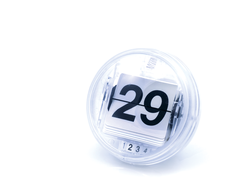Managing appointments and contacts with Osmo
Osmosis

© Alvin Teo, Fotolia
Thanks to its compact interface, the Osmo PIM application is perfect for small screens. We help you make the most of Osmo.
Osmo [1] is a simple tool for managing appointments, contacts, and notes. The Osmo personal information manager, which is based on the Gtk+ toolkit, is designed to run easily on systems with restricted screen space. Versions are currently available for desktop systems as well as Internet tablets. I tried out the September 2008 Osmo 0.2.4 release on a desktop computer with Mandriva 2009.0 and an IdeaPad S10e running Ubuntu 8.10.
Interface
To launch the program, type osmo & in a terminal emulator (Figure 1). On startup, Osmo tucks into the system tray in your panel, where it is easily accessible. When you mouse over the icon in the tray, Osmo will show you that day's appointments as a tooltip.
If you just want to check the calendar, pass the --calendar option when you launch Osmo to open the calendar view only. Another interesting start option is --tinygui, which tells Osmo to scale down so that it fits a small screen.
[...]
Buy this article as PDF
(incl. VAT)
Buy Linux Magazine
Subscribe to our Linux Newsletters
Find Linux and Open Source Jobs
Subscribe to our ADMIN Newsletters
Support Our Work
Linux Magazine content is made possible with support from readers like you. Please consider contributing when you’ve found an article to be beneficial.

News
-
Parrot OS Switches to KDE Plasma Desktop
Yet another distro is making the move to the KDE Plasma desktop.
-
TUXEDO Announces Gemini 17
TUXEDO Computers has released the fourth generation of its Gemini laptop with plenty of updates.
-
Two New Distros Adopt Enlightenment
MX Moksha and AV Linux 25 join ranks with Bodhi Linux and embrace the Enlightenment desktop.
-
Solus Linux 4.8 Removes Python 2
Solus Linux 4.8 has been released with the latest Linux kernel, updated desktops, and a key removal.
-
Zorin OS 18 Hits over a Million Downloads
If you doubt Linux isn't gaining popularity, you only have to look at Zorin OS's download numbers.
-
TUXEDO Computers Scraps Snapdragon X1E-Based Laptop
Due to issues with a Snapdragon CPU, TUXEDO Computers has cancelled its plans to release a laptop based on this elite hardware.
-
Debian Unleashes Debian Libre Live
Debian Libre Live keeps your machine free of proprietary software.
-
Valve Announces Pending Release of Steam Machine
Shout it to the heavens: Steam Machine, powered by Linux, is set to arrive in 2026.
-
Happy Birthday, ADMIN Magazine!
ADMIN is celebrating its 15th anniversary with issue #90.
-
Another Linux Malware Discovered
Russian hackers use Hyper-V to hide malware within Linux virtual machines.

